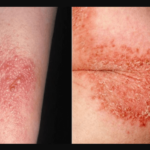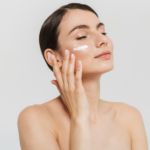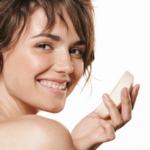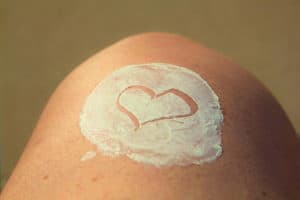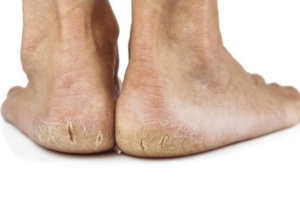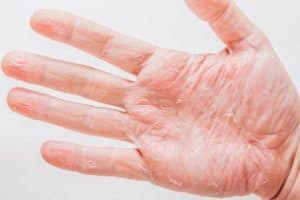Do you have dry or dehydrated skin? Did you know there’s actually a difference between the two? In this post, I want to address the question of how to get rid of dry or dehydrated skin.
Dry skin is a skin type, but dehydrated skin is a condition anyone can experience. Use a Hyaluronic Acid Serum to get rid of both dry or dehydrated skin. It greatly increases your skin’s ability to hold in the moisture without breaking you out or making you feel greasy.
This is a long post as I wanted to cover many topics, including not only dehydrated and dry skin but also humectants, occlusives, different myths I constantly hear, and more. Read on to learn how to get rid of dry or dehydrated skin!
How to Get Rid of Dry or Dehydrated Skin?
Your Skin Might Be Dehydrated, Not Just Dry
If you’re experiencing dry, flaky, itchy, scaly, sensitized skin, you may have dry or dehydrated skin. As we get into the cold winter months, we start experiencing oscillating temperatures between the outside cold air and the heater inside, which dries out the air as well as dehydrates your skin. Your skin starts to experience more chapped, flaky, itchy conditions.
The clinical appearance of dehydrated skin is crinkly, flakey, and also shiny-looking. It almost has a cellophane look to the skin. This is especially obvious when a client has oily skin but is also dehydrated. What happens is the oil gets trapped under that flaky and oily skin. Sometimes, you’ll see it with clients who have been using Retin-A or who’ve done an acid peel recently.
They’ll have really shiny tight looking skin, but it’s also kind of crinkly. That is a symptom of dehydrated skin. When someone does an acid peel when they’re using Retin-A or retinoids or glycolic acid or any type of product that helps them exfoliate a lot faster, they are compromising the lipid barrier in which it draws out the moisture and compromises the ceramide. That’s why you get that appearance of dehydrated skin.
Sensitized vs Sensitive Skin
Many people who think they have sensitive skin actually have sensitized skin. Your skin is sensitized because your skin is dehydrated, and it’s been dehydrated for an extended period of time. You don’t have an acid mantle, and it’s stripped. Therefore, you start experiencing dry, flaky, itchy, red, chapped skin.
Sensitization is actually one of the worst results of dehydrated skin. When you have dehydrated skin, the inflammation signals the middle of proteinases, otherwise known as MMP’s to break down the existing collagen, which actually causes premature aging. Believe it or not, dehydrated skin actually increases premature aging of the skin almost more than anything else.
Skin is Like Bricks and Mortar
First, we’re going to talk about the top layer of the skin, most commonly known as the epidermis but more specifically known as the stratum corneum. The stratum corneum actually plays a key role in the function, health, and maintenance of your skin.
I want you to picture a brick wall. The individual bricks are going to represent the corneocytes or the dead skin cells. The dead skin cells are actually a complex integration of salts, amino acids, urea, and lactic acids. This is referred to as the natural moisturizing factor or NMF.
The mortar or the cement in between that holds those bricks together is the intercellular cement, intercellular bond, or intracellular glue; those are all used interchangeably.
The cement or mortar is actually made up of ceramides, fatty acids as well as cholesterol. The mortar essentially organizes itself into layers of the skin which creates a water-binding material for it. When there is a breakdown in that cement, so to speak, or it starts to break down, then the skin loses its ability to hold on to its own moisture.
A Breakdown in Ceramides Leads to Water Loss and a Decrease in the Skin Cell Turnover Rate
Ceramides are natural lipids that hold the skin cells together. Ceramides are actually vital for moisturizing the skin. When there is a breakdown in the ceramides, your skin will become dry, irritated, and sensitized.
When your skin starts to lose its own moisture, loses its ability to hold on to its moisture, then you start to experience TEWL — Transepidermal Water Loss. This can lead to inflammation and additional UV exposure, and it could actually lead to the breakdown of the extracellular matrix.
Without enough moisture, the natural desquamation process is interrupted. Desquamation is the speed at which the skin cell turns over; or the skin cell turnover rate. When the desquamation rate is interrupted due to the lack of moisture, then the result of the appearance of the skin looks more aged. You’ll get dry, flaky, more sensitized skin, a decrease in elasticity, as well as just the overall appearance looks duller.
When your skin cell turnover rate decreases, you start having more buildup of dead skin cells. This not only traps the dirt and debris, it actually decreases your skin’s ability to absorb any anti-aging ingredients or acne-fighting ingredients, or any other products that you apply onto your face.
Myth #1: Drinking More Water Will Cure Dry or Dehydrated Skin
Drinking more water will not necessarily cure dry or dehydrated skin. When you drink a lot of water, what immediately happens is about twenty to thirty minutes later, you’re going to have to go to the bathroom. Your body will direct that water to the excretory system first before it even reaches the superficial layers of the skin. It’s designed to survive and flush out all of your toxins and metabolic wastes.
Drinking water does help the skin indirectly by flushing out all of the waste so that you have a better skin tone. If you’ve ever seen someone who is very sickly, they’re not eating a lot, they’re not moving around a lot, and they’re not drinking water a lot. They will have this kind of grayish tinge undertone on their skin. Drinking water flushes out a lot of the waste before it reaches the top layers of the skin.
But dry or dehydrated skin is more a cause of external factors than internal factors such as drinking more water. Some external factors include 1. Lack of the right products on your skin to help draw moisture into the skin; 2. Not using the products correctly; 3. Environmental factors such as heat, wind, or dry air.
Yes, it is important to drink enough water, but there is a point where drinking more and more water won’t help you; instead, you need to address external factors.
Myth #2: Using a Heavier Cream Will Cure Dry or Dehydrated Skin
Myth number two that I hear a lot of times is that you need a heavy cream or heavy night cream because your skin is dry. Dehydrated skin actually does not need heavy cream. It needs water and not oil. Heavier creams are created or formulated for dry skin.
What heavier cream does to dehydrated skin is it actually sits on top of the dehydrated skin, and it doesn’t add any additional moisture, which is water, into the skin. What it can do to dehydrated skin that wants water is that it can actually leave the skin feeling greasy.
If you feel the actual texture of your skin, it doesn’t feel like it has any moisture. It just feels like it’s dry underneath and kind of slippery, so that’s when you know you have dehydrated skin.
Humectants vs Occlusives
For those of you out there who have oily skin or breakout-prone skin, I can already hear you guys saying I don’t need any moisturizers. A lot of my acne-prone clients who come to me, I tell them that their skin is dehydrated, it’s producing too much oil, which then feeds the bacteria that causes the acne; they do not want to use moisturizers.
When they use acne-fighting ingredients that actually absorb a lot of the oil, their skin starts to get dry dehydrated, flaky and that clears up the acne. Then they think, okay, my face is finally clear, and I’m not gonna add any more moisturizers to the skin.
Well, your skin needs water-based moisturizers versus oil-based moisturizers. The oil-based moisturizers are occlusive. They keep moisture in and keep the moisture from evaporating. It does not add any moisture to the skin. When your skin is dehydrated, it needs water.
For acne breakout-prone people, you do need a moisturizer. You just need a water-based one, not oil-based. When your skin is dehydrated, your skin will actually over-produce oil to basically slow down its own moisture loss, which then causes more acne.
All of my acne clients and people who are struggling with oily skin or breakout-prone skin, this is why all of them shy away from moisturizers because they think that it makes them break out. Yes, kind of, but not really.
Typically, when you’re using an oil control or an acne-medicated product that controls the acne, it actually sucks up all the oil because bacteria feeds off the lipids or the oil on your skin. When you typically put on lotions, creams, or oils, it makes you break out.
When you’re drying out your skin, you’re over dehydrating your skin. You need to add water-based or binding humectants onto your skin. If you increase the moisture levels in your skin, you actually produce less oil which then results in fewer breakouts, so you want to look for that.
Remember, oil causes breakouts in breakout-prone skin or oily prone skin, and water increases hydration. When you hydrate your skin, you produce less oil. Dehydrated skin or dehydration to the skin actually causes more damage to the skin than dry skin.
Humectants
I keep talking about humectants and how they draw moisture to the skin and how occlusives actually keep the moisture in. The first ingredient we’re going to talk about is the humectant. These are some ingredients that you can look for in your products. The higher they are up in the ingredients list, the better it is.
The first one is glycerin or urea. Basically, they are vegetable-based humectants. It draws moisture to the skin and in the skin. It actually adds moisture to the skin cells as well. The next one is sodium PCA.
If you see this in your ingredients, it actually holds up to 250 times its weight in water. The next one is lactic acid. It is a gentle exfoliating acid. It’s an AHA, but it is a hydrophilic acid which means water-loving. It binds the moisture or binds the water into your skin.
It also helps with exfoliating and treating hyperpigmentation. The big guns for humectants are, of course, hyaluronic acid or otherwise known as sodium hyaluronate. It is also a moisture-binding or water-binding molecule. It can hold up to a thousand times its weight in water, so it is a big-time humectant.
It actually draws moisture from the air or from products that bind it into your skin. When answering, “How to get rid of dry or dehydrated skin?”, the first suggestion I will provide is to start using a humectant moisturizer.
Occlusives
What occlusives do is they actually lock in the moisture that the humectants have brought into your skin. This is a situation where you can use the two hand in hand. Your skin always needs the humectants first and then the occlusives on top of that.
The best way to use the products that contain occlusives is right after you’ve gotten out of the shower. Make sure that you do not completely dry off. You can dry off your crotch and underarm area so that you don’t get yeast growth there. Just pat yourself dry and make sure your skin is moist from the steam and heat.
When your skin is moist, and your pores are open, that’s the best time to put lotion or creams to seal in that water that’s already on your skin. So, that is the best way to use occlusive, whether it’s after a shower or after bath oil or lotion.
Once again, I do want to emphasize this because this gets mixed up with my clients – occlusive agents do not add moisture to the skin. A lot of them have limited benefits. They basically lock the moisture in your skin.
Occlusives That DON’T Benefit the Skin
Some occlusives have no benefit to the skin and therefore should be avoided. Especially people who are breakout-prone or have oily skin should avoid these. These include petroleum, otherwise known as petrolatum, mineral oil, and lanolin. Some people get reactive to lanolin which is basically sheep sebum.
Occlusives That DO Benefit the Skin
Here are three occlusive agents that actually have some benefits to your skin. The first one is sweet almond oil. It’s high in an antioxidant which is vitamin E. The second one is jojoba oil. Jojoba oil is actually very close to human sebum. It actually gets into your skin very easily.
It also contains essential fatty acids as well as some antioxidants. The other one is shea butter. Shea butter is extremely beneficial for dry skin without feeling greasy.
It actually has essential fatty acids, triglycerides, and vitamin A and E. Finally, there’s niacinamide. Niacinamide actually reduces breakouts. It actually increases ceramide and essential fatty acid production or levels as well as reduces tool.
Niacinamide in the retail arena is actually more touted as an anti-aging agent, but it actually is an occlusive agent as well. It helps reduce moisture loss.
Use a Hyaluronic Acid Serum to Treat Dry or Dehydrated Skin
The pro tip is hyaluronic acid serum is not only a humectant, but it also acts as an occlusive agent. It never breaks you out because we make it in our own bodies. Hyaluronic acid can hold up to a thousand times its weight in water.
It draws in moisture, acting as a humectant, but molecularly it’s larger, so it doesn’t really penetrate the skin. It actually not only quenches the thirst of the skin, so to speak, but it also acts as an occlusive agent to seal in more moisture.
If you use a hyaluronic acid serum, it would greatly increase your skin’s ability to hold in the moisture without breaking you out or making you feel greasy. The correct way to use a hyaluronic acid serum and the more effective way to increase the absorption rate in the skin is after cleansing, you exfoliate.
Exfoliate only at night, preferably on clean, dry skin, and add the serum. Most serums need you to wait about 10 minutes to let it penetrate.
The great thing about hyaluronic acid is it is hydrophilic, and it loves water. It is going to be pH compatible with any of the products that you use. While your skin is still moist using the hyaluronic acid serum, use a spray toner, and spray your face with toner until it’s completely saturated.
Just add your favorite toner, like one of our recommended toners, into a spray bottle. Again, while your face is still wet, apply the occlusive agent, which is your moisturizer, lotion, or cream.
Conclusion – How to Get Rid of Dry or Dehydrated Skin?
So, how to get rid of dry or dehydrated skin?
Dehydrated skin is a condition anyone can experience, whereas dry skin is a specific skin type. Use a good Hyaluronic Acid Serum to get rid of both dry or dehydrated skin. It holds in moisture and without breaking you out or making you feel greasy.
Related Questions
What is the fastest way to get rid of dehydrated skin? In addition to using a hyaluronic acid serum, other tips include:
- Avoid alcohol and caffeine
- Avoid harsh face scrubs
- Do not over-exfoliate your skin
- Only wash your face with a gentle cleanser and tepid water
How long does dehydrated skin take to heal? It can take for most people about 2 weeks to fully heal dehydrated skin. After it is healed, it is important to maintain the use of the right lifestyle and the right products with beneficial ingredients.
How can you tell if your skin is dehydrated? An easy way to check if your skin is dehydrated at home is to pinch your skin over the back of the hand or on the lower arm and then release it. Normal skin snaps back rapidly. Dehydrated skin returns slowly.

![Neutral Skin Tone Defined [and Best Colors for Neutral Skin] neutral skin tone](https://skincaregeeks.com/wp-content/uploads/2021/05/neutral-skin-tone-150x150.png)

